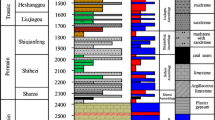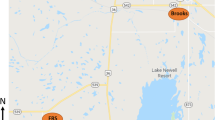Abstract
A wellbore and a combined reservoir system are essential for the management of subsurface fluid resources and the geological storage of CO2. But the interaction between wellbore and reservoir flow is often neglected in studies of the combined system. A 2D radial model, considering the interaction of wellbore and reservoir flow was developed to investigate its impact on CO2 geological sequestration. The mass, energy and momentum equations for the wellbore and reservoir were solved using T2Well/ECO2N. The gas flow rate of the reservoir and wellbore are predicted, and the impact of interaction between wellbore and reservoir flow on the CO2 plume distribution and evolution was investigated. Furthermore, the influence of the CO2 injection rate, reservoir properties and salinity on the distribution of wellbore and reservoir flow was also explored. Interaction between the wellbore and reservoir flows determines the distribution of the reservoir gas flow rate which combined with layer thickness and porosity controls the horizontal distribution and evolution of the CO2 plume. The CO2 wellhead injection rate and reservoir properties (including lateral transmissivity, permeability) are vital factors influencing wellbore and reservoir flows. However, reservoir salinity has little effect on the interaction between the wellbore flow and the reservoir flow, but increased reservoir salinity can accelerate the horizontal migration of CO2. The results of this study may help to change the widely held opinion that the distribution of the injected CO2 among the individual layers is simply proportional to their transmissivity, and thereby enhance our understanding of CO2 evolution beneath the surface and provide theoretical support for safe and potential geological storage of CO2.











Similar content being viewed by others
Abbreviations
- K :
-
The index for components, k = 1 (H2O), 2 (salt), 3 (CO2), and 4 (energy)
- M k :
-
The accumulation terms of the components and energy k, kg m−3
- q k :
-
Source/sink terms for mass or energy components, kg m−3 s−1
- F k :
-
The mass or energy transport terms along the borehole due to an advective process, W m−1
- \(X_{{_{\beta } }}^{{^{k} }}\) :
-
Mass fraction of component k in fluid phase β, (β = G, gas, β = L, liquid), dimensionless
- ρ β :
-
The density of phase β, kg m−3
- S β :
-
Saturation of phase β, dimensionless
- u β :
-
The Darcy’s velocity in phase β, m s−1
- A :
-
The well cross-sectional area, m2
- z :
-
Distance along-wellbore coordinate (can be vertical, inclined, or horizontal), m
- U β :
-
The internal energy of phase β per unit mass, J kg−1
- \(\frac{1}{2}u_{\beta }^{2}\) :
-
The momentum of phase β per unit mass, J kg−1
- λ :
-
Thermal conductivity, W K−1 m−1
- h β :
-
The specific enthalpy of phase β, J kg−1
- g :
-
Gravitational acceleration constant, m s−2
- θ :
-
The angle of inclination of the wellbore, dimensionless
- q″:
-
The wellbore heat loss/gain per unit length of wellbore, kg m−3 s−1
- T :
-
Temperature, C, K
- T :
-
Time, s
- C 0 :
-
The profile parameter (or distribution coefficient), dimensionless
- u d :
-
Drift velocity, m s−1
- ρ m :
-
The density of the gas–liquid mixture, kg m−3
- u m :
-
The mixture velocity (velocity of the mixture mass center), m s−1
- ρ *m :
-
The profile-adjusted average density, kg m−3
- u in :
-
The flow in mass flow rate of wellbore block, kg s−1
- u out :
-
The flow out mass flow rate of wellbore block, kg s−1
- u reservoir :
-
The mass flow rate at the interface of wellbore and reservoir, kg s−1
- \(\upsilon_{\text{m}}\) :
-
The CO2 migration velocity, m s−1
- \(u\) :
-
Reservoir gas flow rate, kg s−1
- H :
-
Layer thickness, m
- \(\phi\) :
-
Porosity, SI
- s s :
-
Solid saturation, SI
- \(\phi_{\text{r}}\) :
-
The fraction of original porosity, SI
References
Aradóttir ES, Sigurdardóttir H, Sigfússon B, Gunnlaugsson E (2011) CarbFix: a CCS pilot project imitating and accelerating natural CO2 sequestration. Greenh Gases Sci Technol 1:105–118
Bachu S (2008) CO2 storage in geological media: role, means, status and barriers to deployment. Prog Energy Combust Sci 34:254–273
Bauer S, Class H, Ebert M, Feeser V, Götze H, Holzheid A, Kolditz O, Rosenbaum S, Rabbel W, Schäfer D (2012) Modeling, parameterization and evaluation of monitoring methods for CO2 storage in deep saline formations: the CO2-MoPa project. Environ Earth Sci 67:351–367
Class H, Ebigbo A, Helmig R, Dahle H, Nordbotten J, Celia M, Audigane P, Darcis M, Ennis-King J, Fan Y, Flemisch B, Gasda S, Jin M, Krug S, Labregere D, Naderi Beni A, Pawar R, Sbai A, Thomas S, Trenty L, Wei L (2009) A benchmark study on problems related to CO2 storage in geologic formations. Comput Geosci 13:409–434
Delshad M, Kong XH, Tavakoli R, Hosseini SA, Wheeler MF (2013) Modeling and simulation of carbon sequestration at Cranfield incorporating new physical models. Int J Greenh Gas Control 18:463–473
Dooley JJ, Kim SH, Edmonds JA, Friedman SJ, Wise MA (2003) A first order global geological CO2 storage potential supply curve and its application in a global integrated assessment model. Joint Global Change Research Institute University of Maryland
Frailey SM, Finley RJ (2011) CO2 plume management in saline reservoir sequestration. Energy Procedia 4:4238–4245
Freifeld B, Zakim S, Pan L, Cutright B, Sheu M, Doughty C, Held T (2013) Geothermal energy production coupled with CCS: a field demonstration at the SECARB Cranfield site, Cranfield, Mississippi, USA. Energy Procedia 37:6595–6603
Giorgis T, Carpita M, Battistelli A (2007) 2D modeling of salt precipitation during the injection of dry CO2 in a depleted gas reservoir. Energy Convers Manag 48:1816–1826
Gislason SR, Wolff-Boenisch D, Stefansson A, Oelkers EH, Gunnlaugsson E, Sigurdardottir H, Sigfusson B, Broecker WS, Matter JM, Stute M (2010) Mineral sequestration of carbon dioxide in basalt: a pre-injection overview of the CarbFix project. Int J Greenh Gas Control 4:537–545
Griffith CA, Dzombak DA, Lowry GV (2011) Physical and chemical characteristics of potential seal strata in regions considered for demonstrating geological saline CO2 sequestration. Environ Earth Sci 64:925–948
Han WS, Kim K, Lu M, McPherson BJ, Lu C, Lee S (2011) Injectivity changes and associated temperature disequilibrium: numerical study. Energy Procedia 4:4552–4558
Hashim ET, Maloka IE (2006) Static bottom-hole pressures in wells. Pet Sci Technol 24:113–116
Hitchon B, Gunter WD, Gentzis T, Bailey RT (1999) Sedimentary basins and greenhouse gases: a serendipitous association. Energy Convers Manag 40:825–843
Hurter S, Berge J, Labregere D (2007) Simulations for CO2 injection projects with compositional simulator. In: Offshore Europe
Kumar A, Noh M, Pope GA, Sepehrnoori K, Bryant S, Lake LW (2004) Reservoir simulation of CO2 storage in deep saline aquifers. In: SPE/DOE symposium on improved oil recovery. Society of Petroleum Engineers
Lindeberg E (2011) Modelling pressure and temperature profile in a CO2 injection well. Energy Procedia 4:3935–3941
Lu M, Connell LD (2008) Non-isothermal flow of carbon dioxide in injection wells during geological storage. Int J Greenh Gas Control 2:248–258
Luo F, Xu R, Jiang P (2014) Numerical investigation of fluid flow and heat transfer in a doublet enhanced geothermal system with CO2 as the working fluid (CO2–EGS). Energy 64:307–322
Ng H, Carroll JJ, Maddocks J (1999) Impact of thermophysical properties research on acid gas injection process design. Gas Processors Association, pp 114–120
Pan L, Oldenburg CM (2014) T2Well—an integrated wellbore–reservoir simulator. Comput Geosci 65:46–55
Pruess K (2005) ECO2N: A TOUGH2 fluid property module for mixtures of water, NaCl, and CO2. Lawrence Berkeley National Laboratory Berkeley
Pruess K, Müller N (2009) Formation dry-out from CO2 injection into saline aquifers: 1. Effects of solids precipitation and their mitigation. Water Resour Res 45:W3402
Pruess K, Spycher N (2007) ECO2N––a fluid property module for the TOUGH2 code for studies of CO2 storage in saline aquifers. Energy Convers Manag 48:1761–1767
Pruess K, Moridis GJ, Oldenburg C (1999) TOUGH2 user’s guide, version 2.0. Lawrence Berkeley National Laboratory Berkeley
Ruan B, Xu R, Wei L, Ouyang X, Luo F, Jiang P (2013) Flow and thermal modeling of CO2 in injection well during geological sequestration. Int J Greenh Gas Control 19:271–280
Shao HB, Ray JR, Jun YS (2011) Effects of salinity and the extent of water on supercritical CO2-induced phlogopite dissolution and secondary mineral formation. Environ Sci Technol 45:1737–1743
Siriwardane HJ, Gondle RK, Bromhal GS (2013) Coupled flow and deformation modeling of carbon dioxide migration in the presence of a caprock fracture during injection. Energy Fuels 27:4232–4243
Zuber N, Findlay JA (1965) Average volumetric concentration in two-phase flow systems. J Heat Transf 87:453–468
Acknowledgments
This work was supported by project 201211063 of the Ministry of Land and Resources of PRC, and the China Australia Geological Storage of CO2 Project Phase 2 (CAGS2).
Author information
Authors and Affiliations
Corresponding author
Rights and permissions
About this article
Cite this article
Liu, D., Li, Y., Xu, L. et al. Numerical investigation of the influence of interaction between wellbore flow and lateral reservoir flow on CO2 geological sequestration. Environ Earth Sci 74, 715–726 (2015). https://doi.org/10.1007/s12665-015-4076-5
Received:
Accepted:
Published:
Issue Date:
DOI: https://doi.org/10.1007/s12665-015-4076-5




